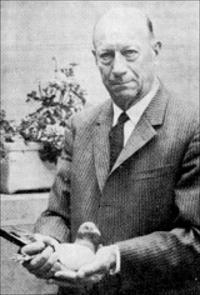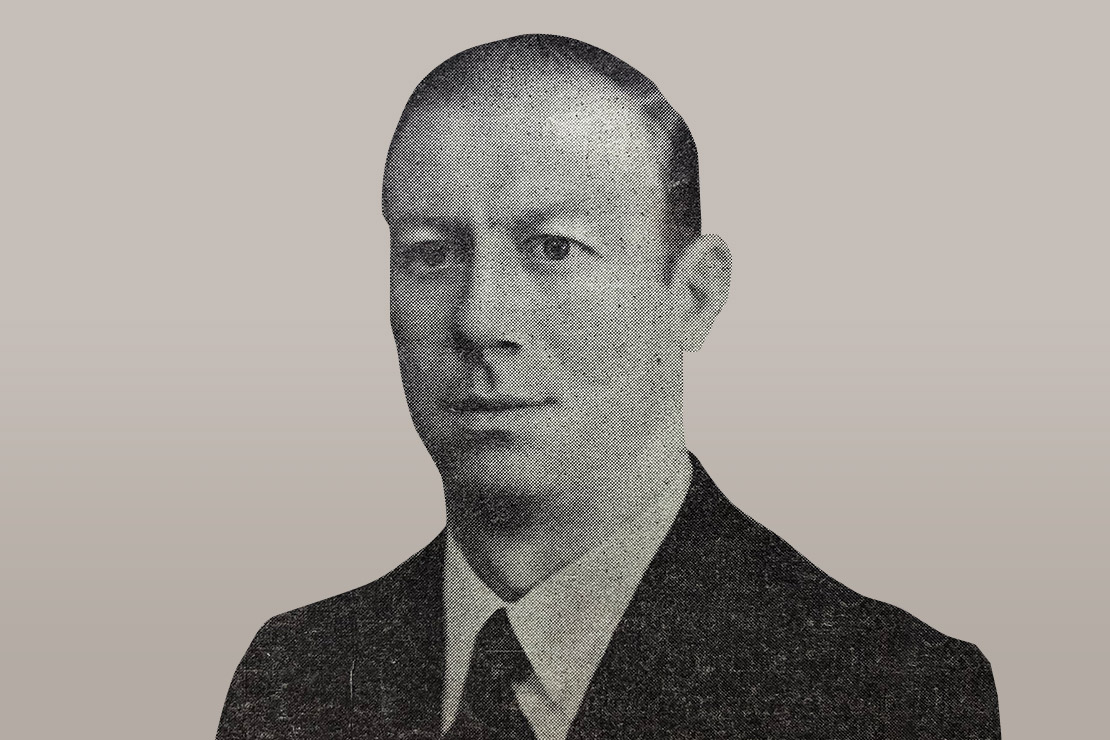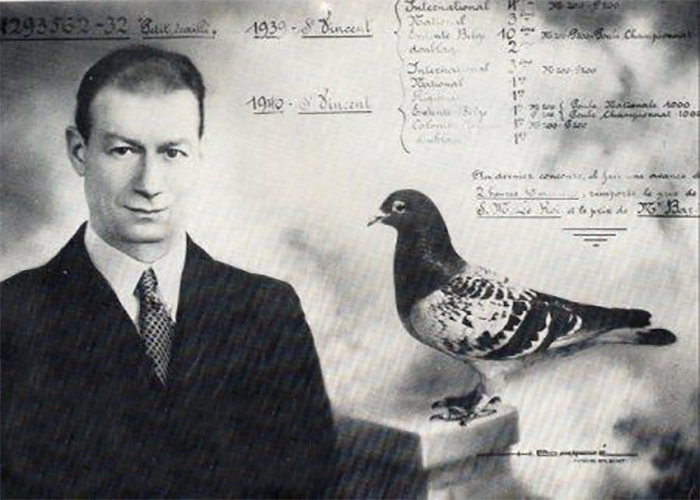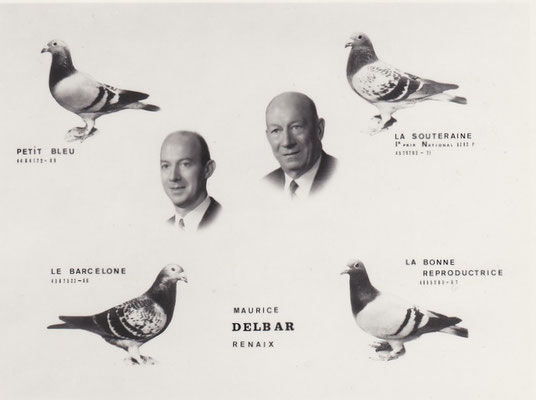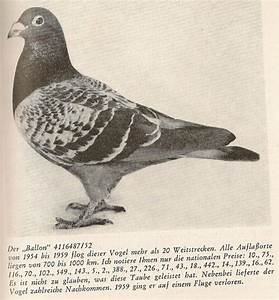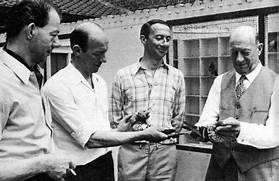Maurice Delbar
Maurice Delbar, Master Breeder & Racer, was born 1899, in Ronse, Belgium.
- Steve O'Dea
- March 24, 2021
- 6:58 pm
Watch, Listen or Read about The Delbar Family of Racing Pigeons below here....
 “…..His main competitors were champions with his pigeons, breeding pure or crossed – the likes of Berlengee, Dath, Delvinquiere, Dusarduyn etc. they all used Delbars own bird’s to compete with him.”
“…..His main competitors were champions with his pigeons, breeding pure or crossed – the likes of Berlengee, Dath, Delvinquiere, Dusarduyn etc. they all used Delbars own bird’s to compete with him.”
From the French speaking part of Belgium, is the little town of Ronse, home to one of the most famous racing pigeon fanciers of the 20th Century, his name was Maurice Delbar. The famous Delbar strain name which we know of today, derives mainly from Maurice Delbar, who succeeded his famous father Oscar in the sport, and even before the carnage of the First World War the name was a noted one amongst the European pigeon racing fraternity.
He had an unbeatable long distance strain that had achieved results, that were the equal of those of Bricoux and Duray. His family of pigeons had reaped numerous wins at distances of between 400 and 700 miles, especially for a period of approximately 20 years after the war ended as the family went on to further glory
His strain was a master of the Pyrenees races, in the race home his birds kept at the head of the race, and never was the sport so overwhelmed by a single lofts results between 1935 and ’40. His main competitors were champions with his pigeons, breeding pure or crossed – the likes of Berlengee, Dath, Delvinquiere, Dusarduyn etc. they all used Delbars own bird’s to compete with him.
The Delbar breed is so rich in pure class that it crosses-out well with lots of other breeds. Discovered in the Netherlands and Germany with Janssens after the war. In fact, during the 30’s and 40’s, most fanciers heard only of the Delbars, the Hansennes and the Putmans in that order as being the major sources of pigeon racing success. A key factor of their success was the crossing of some birds into the family from a Mr. De Peeters loft from Puttee, not far from Mechelin. Thus lay the basis of the strain: the pre-war Delbar family and the post- war input from the De Peeters.
It must be stated, however, that the crosses into the Delbars were few at this time. However, upon its arrival, the crossed Delbar/De Peeter strain took the pigeon racing world by storm, and success flourished not only for the master himself but for hundreds of disciples from throughout the whole of the pigeon sport.
In 1937, Delbar won the Barcelona marathon and approximately 10 years later, 1948, the Barcelona race was won by a 100% Delbar raced by the famous Berlengee. Numerous other fanciers throughout the planet won other distance, and indeed, shorter races. These successes are too numerous to mention but the whole phenomenon reflected the impact of this unique strain on the world pigeon racing community.
What is little known about Maurice Delbar is that he kept an exceptional family of grizzles. The descendants of his “Golden Grizzles” made many a Belgian and German fancier famous after World War II. During the years of his fame, the entire world knew of his world champion flyer “Little Chequer”. Born in the year 1932, “Little Chequer” dominated the National St. Vincent races. He placed an amazing 2 X 1st National plus 2nd, 3rd, 4th, and 10th National during his racing career. A better racing pigeon probably has never existed.
 “….These successes are too numerous to mention but the whole phenomenon reflected the impact of this unique strain on the world pigeon racing community.”
“….These successes are too numerous to mention but the whole phenomenon reflected the impact of this unique strain on the world pigeon racing community.”
Around this same time, Mr. Delbar purchased a grizzle hen from an unknown fancier in his area and in 1934 bred the “Little Chequer” with “The Grizzle Hen”. Descendants of this pairing, later to be known as the “Delbar Grizzles”, turned out to be exceptional racers and breeders for many famous flyers. One example is the “Super Grizzle” cock of Hector Berlengee. This cock won 14 times in the top 100 when entered in National races of between 450 to 600 miles. The “Super Grizzle” was 100% pure Delbar Grizzle.
It is understood in Germany, that the “Golden Grizzle” Hen purchased by Thomas Peeters carried the Delbar Grizzle in her veins. This famous stock hen is considered by many to be the world’s best breeding hen. One of her direct sons was the Champion “Barcelona” bred by Peeters. This famous cock, born in 1970 won 1st National St. Vincent twice, flying a race distance of more than 560 miles.
Peeters’ key stock bird, “Korte Bek” Belgium 1975; is a grandson of the “Golden Grizzle” Hen as is the “Kleine Molenaar”, 1st National Ace Pigeon Long Distance in 1977 and 3rd National Ace pigeon Long Distance 1980. The strength of these Delbar grizzles can be seen even in Jos Thones last big champion (1st Provincial Ace Pigeon KBDB), which is also of this family.
Maurice Delbar kept good relations with some German businessmen like Mr. Carl Goschalla, Mr. Kreutz, Mr. Holland, etc. and these men were able to purchase children of the key breeders and champion racers from Mr. Delbar, especially the Golden grizzle Delbars. These Golden grizzle Delbars are still today winning very good national prizes especially from Barcelona and Marseilles. In Germany, it was found that the Golden grizzle Delbars crossed well with the Janssen, Meuleman, Grondelaers and the Hofkens birds.
The Golden grizzles are also excelling at the shorter distance races on the southeast and east race courses out of Austria and Poland. These are headwind courses are very dangerous for the birds because of the many miles of mountains, forest, and the many hawks and falcons to be found there.
Some of the well-known southeast release points are: Vienna, St. Poelten, Linz, and Komarno. The east course into Poland has the release points of Posen, Goerlitz, Sulecin, and Krakow etc. These Delbar based birds are bred to race over tough terrain and win! These “East Course” birds are of small to medium size, not heavy in the hand!
We should also acknowledge that the Jan Aarden dynasty was based upon a number of Delbar pigeons amongst others, and that the Delbar strain has influenced other modern pigeon racing strains such as the Jos Thones. In fact, Piet de Weerd had supplied Aarden with a Delbar which lay at the base of the latter’s strain. As for the successful grizzles of the Thone strain, many contained Delbar genes.
Delbar eventually brought in many crosses but his strain through his husbandry remained phenotypical and it was a strain that many fanciers could identify very accurately as being the work of the artist of Ronse. The Delbar breed of pigeons has fired the imaginations of countless fanciers throughout the world, those who have raced and been successful with representatives of the Delbar family.
The DELBAR breed of pigeons has fired the imaginations of countless fanciers throughout the world, those who have raced and been successful with representatives of the Delbar family.
The Delbar’s were introduced to Ireland in the late 40’s / early 50’s. One of the best-known racers to have success with these birds was Bill Troughton from Portadown Co. Armagh. He first introduced the famous Delbars into his loft in 1962 and it was then that Bill’s results really started to soar. It would be impossible to catalogue all the best of his birds; but of note must be the blue Chequered Cock (NU 67 T 28845), which twice won the open in 1970 with the NIPA against very large birdages. It helped Bill to win the McCluggage cup for the best average in all cross channel races with the NIPA. Then there was the blue chequered hen that took the Young bird national win from Penzance in 1972 and was the mother of his blue tip cock that was lost going for a hall of fame award in 1979, an award that the loft would eventually win with another Delbar in 1990. Another top bird was the Blue hen that won the Dinard Derby with the NIPA in 1977. Then in 1978, Bill won 1st yearling national and in 1979 the INFC young bird national from Penzance against 2,918 birds and scooping over £1,500 in prize money, with two same-way bred Delbar’s.
The history of and longevity of winning Delbar’s in Ireland can be traced back to the early 40’s and throughout the following 80 years no other strain of birds, is more represented in the breeding of INFC King’s cup winners than that of the Delbar’s.
The appeal of Delbar birds has always been the same. They Win, especially when used as a first-cross into existing families. In the 21st century this is nowhere more apparent than in the far eastern countries of China and Taiwan.
Today the strain is the number one family of pigeons in the vast country of China. In fact, there is a national association of Delbar fanciers throughout the Chinese mainland, a situation not envisaged by the Delbar family of the small town of Ronse in Belgium when they first became participants in the sport before the world experienced the horrors of the First World War. In truth Delbar is a strain of which myths and legends have been spun. It rightly however, occupies within the worldwide pigeon fancy, an honourable position as one of the greatest ever pigeon families.

